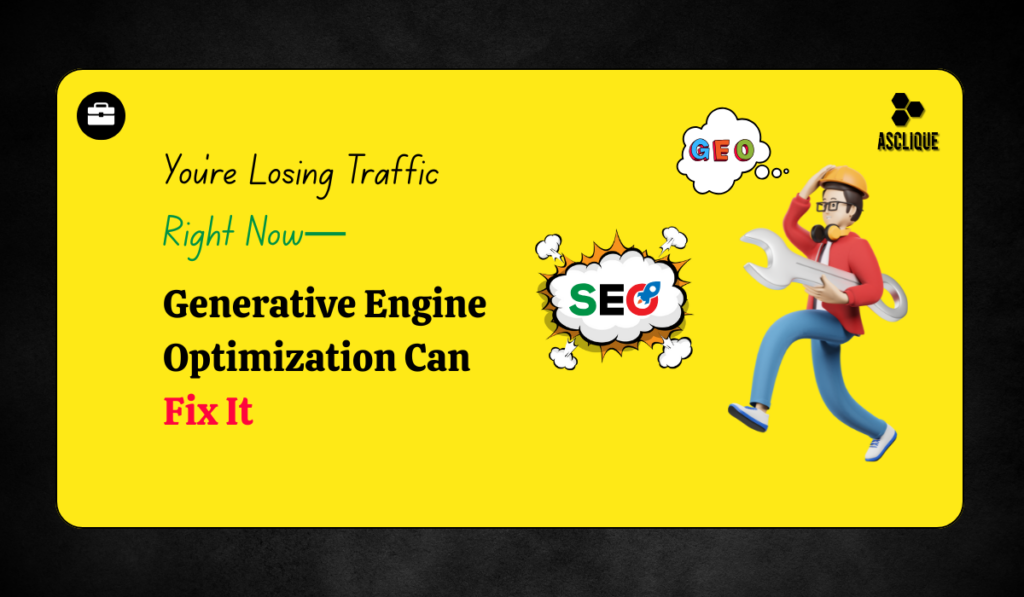Search engines are no longer just about ten blue links on a screen. In recent years, especially with the rise of tools like ChatGPT, Google Bard, and Microsoft’s AI-enhanced Bing, how people interact with search has changed significantly. AI is reshaping the way users get information—offering summarized answers instead of directing them to individual links.
And this is where Generative Engine Optimization (GEO) steps in. It’s the strategy that ensures your content shows up when AI answers someone’s question.
What Is Generative Engine Optimization?
Generative engine optimization refers to a modern approach to content strategy that focuses on making content understandable and relevant for generative AI models. These models don’t just look at keyword density—they look at meaning, clarity, and user intent. GEO helps your content get picked up and shown as part of AI-generated responses across platforms.
Where traditional SEO was designed to please search engine bots, GEO is about aligning your content with how AI engines read and generate answers for real human queries.
Why GEO Matters in 2025 and Beyond
AI-generated content isn’t a prediction anymore—it’s happening now. Google’s Search Generative Experience (SGE) is already rolling out, and platforms like Perplexity.ai and You.com are also using AI to reshape search.
Here are a few compelling stats:
- 67% of U.S. adults say they use some form of AI for information lookup or content generation (Pew Research, 2024).
- Websites featured in generative AI search results have seen a 30–40% increase in traffic, depending on their niche (BrightEdge, 2024).
- Zero-click searches—where users get their answer without clicking a link—have now crossed 65% of total search queries (SparkToro, 2024).
This means that if you’re not showing up in AI responses, you might not be seen at all.
The Foundation of Generative Engine Optimization
GEO isn’t about gaming the system. It’s about being genuinely helpful, clear, and structured so that AI can find and use your content. Below are the foundational elements of an effective GEO strategy:
1. Write With the End-User in Mind
Think about what your audience actually needs. Are they looking for a quick definition, a step-by-step guide, or expert insights? Generative engines scan for concise, well-structured answers. That means breaking up long paragraphs, using bullets, and addressing real questions.
2. Context > Keywords
AI doesn’t just scan for exact-match keywords. It looks for contextual relevance. Instead of stuffing your article with the phrase “generative engine optimization,” explain it with supporting ideas like AI search, user intent, and structured responses.
Use natural language. Synonyms, related terms, and context-rich phrases matter more than keyword stuffing.
3. Structured Data Helps Machines Understand
Using schema markup (like FAQ Page, Article, and HowTo) increases the likelihood of your content being selected by AI engines. It signals structure and makes it easier for machines to know what your content is about.
4. Authoritativeness and Trust
AI tools are selective. They prioritize content from trusted sources with real information. That means:
- Citing statistics and studies
- Including outbound links to credible sources
- Writing under author profiles with expertise
Publishing random content won’t cut it. Trust-building is essential.
5. Refresh Content Regularly
Old content often gets pushed aside by AI engines. If your article hasn’t been updated in 2–3 years, chances are it’s no longer favored by modern algorithms.
Keep your pages fresh, relevant, and up-to-date. Even small updates can make a difference.
GEO vs Traditional SEO: What’s the Real Difference?
While both strategies aim to increase visibility, their approach differs greatly.
| Criteria | Traditional SEO | Generative Engine Optimization |
| Target | Search engines (crawlers) | AI and generative models |
| Ranking Style | Position on search results | Presence in AI snippets/answers |
| Primary Focus | Keywords, backlinks, technical SEO | Clarity, accuracy, structure, and intent |
| Results Format | Clickable links | AI summaries, direct responses |
| Content Format | Optimized pages with keywords | Structured, answer-oriented, conversational content |
GEO doesn’t replace SEO—it enhances it for an AI-first world.
How to Start Implementing Generative Engine Optimization Today
✅ Audit Existing Content
Check if your blogs and articles answer questions clearly. Can someone find value in the first 100 words? If not, improve it.
✅ Add FAQs to Key Pages
AI loves FAQs. They’re simple, structured, and answer-focused. Add 3–5 common questions to your landing pages or blog posts.
✅ Use Internal Linking Wisely
Link relevant pages within your site to help AI understand topic clusters and content depth.
✅ Write Like a Human
Avoid jargon, filler, and robotic language. If it sounds unnatural, AI likely won’t use it—and people definitely won’t read it.
✅ Track AI Search Visibility
Some SEO platforms like BrightEdge and Search Console (experimental features) are starting to show AI snippet metrics. Monitor them to see what works.
The True Power of GEO: Visibility Without the Click
With AI-generated responses, there may be no “page one” anymore. The content AI pulls into its answers is the content people see. That’s why generative engine optimization is now critical. It gives you a seat at the table in AI conversations.
Instead of fighting for top spots in a list of links, GEO puts your content directly in the answer. That’s high-value real estate.
Conclusion
As search engines evolve into generative engines, brands must evolve their optimization strategies. Traditional SEO will always have its place, but generative engine optimization is the way forward for true AI-driven search visibility.
By creating structured, clear, and genuinely helpful content, you’re not only optimizing for machines—you’re creating value for your audience.
Invest in GEO today, and you’ll future-proof your digital presence tomorrow.
FAQ’s
Q. How do I optimize my website for generative search?
Start by making your content easy to read, adding FAQs, citing reliable sources, and using schema markup. Focus on being helpful and structured.
Q. Is generative engine optimization important for small blogs?
Yes, absolutely. AI doesn’t favor size—it favors quality. Even smaller blogs can be featured in AI-generated answers if their content is clear and helpful.
Q. What tools help with GEO?
Use tools like Google Search Console, Grammarly, Surfer SEO, and schema.org for markup implementation. AI-writing tools can also assist with formatting.
Q. Will GEO completely replace traditional SEO?
Not likely. Traditional SEO remains important, especially for indexing and crawlability. GEO adds an extra layer focused on AI visibility, not just rankings.

